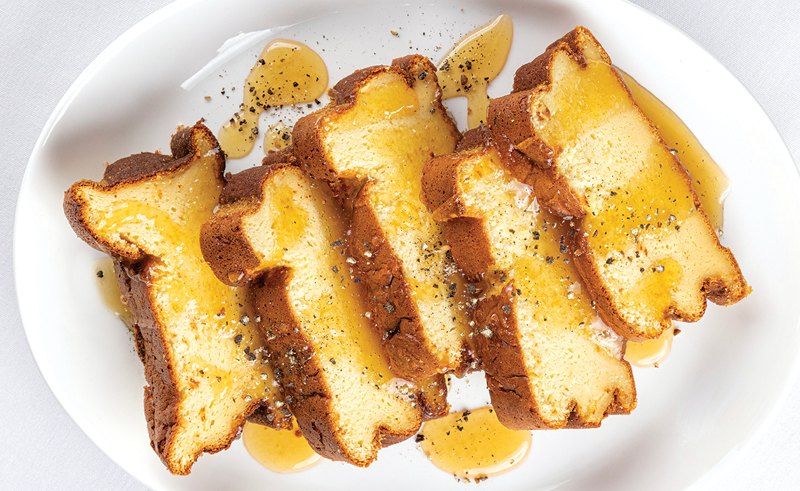
As much as I love gardening (which I love almost as much as cooking), getting the ball rolling in spring is a challenge. Preparing the beds, rebuilding borders, spreading the compost, starting the seeds—it can be overwhelming. But I need to look no further than the beehives to find inspiration to get to work. When I see the bees dashing about cleaning the hives, preparing them for the season’s activities, I, too, feel the pull of the season. And bees naturally make one think of honey, and honey makes me think of eating, and the next thing you know, I’m back in the kitchen, garden chores averted.
As a cook and a beekeeper, I’m always looking for new ways to use honey. It is a fascinating and versatile ingredient. If kept in an airtight container, it can be stored for hundreds, even thousands, of years, and although it may crystallize (form crystals and look cloudy and granular), it is still perfectly viable and delicious. Honey has a lower glycemic index than sugar, meaning it does raise blood sugar rapidly, but not as fast as sugar. In terms of sweetness, it can in most cases be substituted for sugar in equal volume—although depending on the variety, honey’s flavor can be assertive and the moisture content may slightly alter the outcome in baking. Regardless, I keep a jar at hand for whenever I need to add a touch of sweetness to a dish.
My latest use for honey is in a simple cake made with fresh cheese. And although when one hears “cheese” and “honey” and “cake,” a dessert cheesecake springs to mind, this cake can be interpreted as sweet or savory, depending upon the way it is garnished. It could be eaten out of hand with cocktails, topped with tapenade and served aside a salad for a light lunch, or embellished with fresh fruit or candied cherries—and maybe a drizzle of dark-chocolate sauce—for dessert. My current favorite version reinforces its apiarist roots with a generous embellishment of honey and a grind of coarse black pepper—a grown-up treat suitable for any time of day.
Fresh Cheese and Honey Cake
You have to decide (or let your fridge decide for you, based on its contents) which type of fresh cheese you want to use for this cake. I normally use something more intensely flavored like a good feta (see In Your Pantry, Brined Cheeses, October 2021 for more info), but a milder, more creamy goat cheese, ricotta, or a blend of any of those makes a lovely version as well, especially for a cake with dessert aspirations.
Preheat the oven to 400F while assembling the cake. I like to bake this cake in a 9-by-5 loaf pan, although it also bakes nicely in an 8- or 9-inch round pan (the larger round pan cooks quickly and can dry out, so be careful). Butter the inside of whichever pan you use and put in a small handful of plain dry breadcrumbs. Tilt the pan from side to side, tapping lightly and coaxing the breadcrumbs to evenly coat the pan, dumping out any excess crumbs. An aside: the sound of a cake pan being tapped always makes me think of my mother baking a cake, the ding of her wedding band on the pan a notification of sweet things to come. I always wonder if others have similar associations.
Meanwhile, back to baking. Separate 5 eggs. In a food processor, combine the yolks, 10 ounces of feta (or other) cheese, ¼ cup of cornstarch, and ½ cup of honey. Pulse and blend until relatively smooth. In a medium-sized bowl and using a hand mixer (or whisk, if you have enthusiasm and spring vigor), beat the egg whites until frothy and add a big pinch of salt. Continue beating the egg whites, gradually adding in 2 tablespoons of sugar, until firm peaks are achieved (if these words mean nothing to you, do a quick search on YouTube).
Pour the batter from the food processor into a spacious bowl. Fold in one third of the whipped whites until incorporated, then repeat with the remaining whites in two more additions. Pour the mixture into the baking pan and place that on a baking sheet (this helps insulate the bottom so it doesn’t bake too dark). Place the pan in the center of the oven and immediately lower the heat to 350F. After 20 minutes, rotate the pan to ensure even cooking and bake for about 20 minutes more. The cake will have ballooned in size and turned a deep golden brown—and probably have a few cracks in the top. If you insert a thin knife, it will not come out entirely clean, and that’s okay. Remove the cake from the oven and allow it to cool. It will deflate. When cooled, remove the cake from the pan (it should fall out in one piece when inverted). Slice it and serve it at any temperature, drizzled with your favorite honey and a generous grind of black peppercorns or other garnishes.
Perhaps half the fun in eating this little treat is deciding if it is sweet or savory. Regardless, I hope you try it, especially if you are trying to avoid doing something necessary but daunting.
In Your Pantry
Gifts From the Hive
There is more to bees and honey than plastic bear-shaped squeeze bottles. Look for these bee-dazzled products at larger grocery retailers, farmers markets, and health food stores.

Varietal Honey
The same way that wines are influenced by their terroir and place of origin, the flavors of honey are influenced by the plants they pollinate. Although mass harvesters of honey will blend honey from hundreds of hives, keep an eye out for specialty honeys harvested from bees that visit specific types of flowers, forests, and fields. Chestnut, lavender, Manuka, acacia, and orange blossom are just a few of the more popular examples. And they make great edible souvenirs from your travels.

Creamed Honey
Over time, honey can crystallize, especially if it is unfiltered and stored at lower room temperatures. One way to control that process is by creaming or whipping honey. It has the added benefit of making honey wonderfully spreadable, perfect for your next slice of toast. Although you can purchase creamed honey, it is simple to make your own out of neglected honey that has become granular and crystallized, probably residing in the back of the pantry. Just combine equal parts of crystallized and liquid honey in a blender or food processor for a few minutes until it becomes velvety smooth. For a thicker version, store creamed honey in the fridge.

Honeycomb
Bees store their honey in wax hexagons that are both beautiful and edible, as well as being a source for numerous micronutrients. Although many people love the texture, some find the waxiness a distraction. For the best of both worlds, ask a beekeeper (usually at a farmers market) if they have crystallized honeycomb. The texture is like a delicious floral and honeyed candy that you don’t have to feel guilty for eating. Excellent as part of a cheese platter or as one delicious little mouthful at the end of a meal.

Bee Pollen
Bees collect the pollen from flowers to use as a nutritionally dense food source, bringing it back to the hive in little bundles of varying shades of gold. Containing a dazzling array of vitamins, minerals, amino acids, and antioxidants, it tastes faintly sweet and floral, with a pleasantly bitter finish. The uninitiated, especially those with pollen sensitivities and bee venom allergies, should start with a few granules to see if they have an adverse reaction, increasing the amount a little each day. Try it mixed into smoothies, granola, or other cereals, or as a garnish for honey-based desserts.


